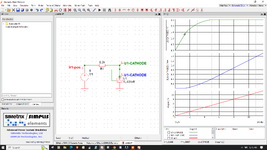cupoftea
Advanced Member level 6

Hi,
If you have a 6k2 resistor feeding the cathode of a TL431 (as attached),
then supposing the voltage rises up from zero steadily.....obviously the
cathode voltage cannot become 2.5V until the rising voltage has reached 6.2V + 2.5V = 9V
But when this rising voltage is below 9V, do you agree, that the v(cathode) of the
TL431 will actually plateau at around 1.9-2.1V , and will only snap up to 2.5V
when the rising voltage reaches 9V.
In other words, the graph of v(cathode) vs I(cathode) on pg 15 of the TL431 datasheet
is only correct for the case of an actual current source feeding the TL431 cathode?
This must be considered because if you want a 2.5V reference, then we must appreciate
that the TL431's cathode current will not always allow us to have a 2.5V reference.
If you have a 6k2 resistor feeding the cathode of a TL431 (as attached),
then supposing the voltage rises up from zero steadily.....obviously the
cathode voltage cannot become 2.5V until the rising voltage has reached 6.2V + 2.5V = 9V
But when this rising voltage is below 9V, do you agree, that the v(cathode) of the
TL431 will actually plateau at around 1.9-2.1V , and will only snap up to 2.5V
when the rising voltage reaches 9V.
In other words, the graph of v(cathode) vs I(cathode) on pg 15 of the TL431 datasheet
is only correct for the case of an actual current source feeding the TL431 cathode?
This must be considered because if you want a 2.5V reference, then we must appreciate
that the TL431's cathode current will not always allow us to have a 2.5V reference.


